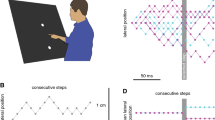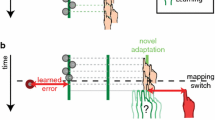Abstract
Human subjects pointed, without seeing their arm, at visual targets presented in repeated sequences in a frontal plane. Required movement direction could change within the sequence by 0, 45, 90, 135 or 180°. Hand position was recorded contact-free in three dimensions (3D). From the recordings, the pointing errors towards each target were transformed into a Cartesian coordinate system with the x-axis representing the mean direction of all movements towards that target. We then investigated the relationship between successive errors by applying linear regression analysis separately to the three Cartesian error components. For the x-component, we found that successive errors were positively correlated throughout the experiment, which confirms our previous finding that errors in sequential pointing tend to accumulate (Bock and Eckmiller 1986; Bock et al. 1990). Correlation dropped by nearly 50% following a direction change of 90° or more, suggesting that accumulation is reduced but not abolished by large changes in movement direction. The slope of the regression line averaged 0.6, which indicates the existence of a complementary trend towards error correction, contributing about 40% towards motor performance. Changes of movement direction affected slope and correlation in a closely similar way, suggesting that reduced accumulation is paralleled by increased correction. For the y- and z-components, we found that successive errors were positively correlated as well, but were not reduced following even large direction changes. This apparent discrepancy can be resolved by assuming separate neural mechanisms for amplitude and for direction control, differing in their sensitivity to direction changes. We discuss our findings in the context of the two predominant motor control hypotheses, the amplitude and the position control models.
Similar content being viewed by others
References
Alexander GE, Crutcher MD (1990) Preparation for movement: neural representations of intended direction in three motor areas of the monkey. J Neurophysiol 64:133–150
Atkeson CG, Hollerbach JM (1985) Kinematic features of unrestrained vertical arm movements. J Neurosci 5:2318–2330
Bizzi E, Accornero N, Chapple W, Hogan N (1984) Posture control and trajectory formation during arm movement. J Neurosci 4:2738–2744
Bizzi E, Mussa-Ivaldi FA, Giszter S (1991) Computations underlying the execution of movement: a biological perspective. Science 253:287–291
Bock O (1989) A neural network predicting posterior parietal cortex function in the control of goal-directed arm movements. Neural Networks 2:351–358
Bock O (1990) Load compensation in human goal-directed arm movements. Behav Brain Res 41:167–177
Bock O, Arnold K (1992) Motor control prior to movement onset: preparatory mechanisms for pointing at visual targets. Exp Brain Res 90:209–216
Bock O, Eckmiller R (1986) Goal-directed arm movements in absence of visual guidance: evidence for amplitude rather than position control. Exp Brain Res 62:451–458
Bock O, Eckmiller R, Andersen R (1987) Goal-directed pointing movements following chemical microlesions within the posterior parietal cortex of trained monkeys. Soc Neurosci Abstr 13:716
Bock O, Dose M, Ott D, Eckmiller R (1990) Control of arm movements in a 2-dimensional pointing task. Behav Brain Res 40:247–250
Desmedt JE, Godaux E (1978) Ballistic skilled movements: load compensation and patterning of the motor commands. Prog Clin Neurophysiol 4:21–55
Favilla M, Hening W, Ghez C (1989) Trajectory control in targeted force impulses. VI. Independent specification of response amplitude and direction. Exp Brain Res 75:280–294
Feldman AG (1966) Functional tuning of the nervous system with control of movement or maintenance of a steady posture. II. Controllable parameters of the muscles. Biophysics 11:565–578
Georgopoulos AP, Caminiti R, Kalaska JF, Massey JT (1983) Spatial coding of movement: a hypothesis concerning the coding of movement direction by motor cortical populations. Exp BrainRes [Suppl] 7:327–336
Ghez C, Bermejo R, Gordon J (1988) Impairment in programming of response direction and amplitude in deafferented patients. Soc Neurosci Abstr 14:953
Godschalk M, Lemon RN, Kuypers HGJM (1981) Behavior of neurons in monkey peri-arcuate and precentral cortex before and during visually guided arm and hand movements. Exp Brain Res 44:113–116
Kelso JAS, Holt KG (1980) Exploring a vibratory system analysis of human movement production. J Neurophysiol 43:1183–1196
LaRue J, Fleury M, BlouinJ, Paillard J, Teasdale N, Forget R, Lamarre Y (1991) Arm control in a deafferented patient (abstract). Third IBRO World Congress of Neuroscience, Montreal
Meyer DE, Smith JEK, Wright CE (1982) Models for the speed and accuracy of aimed movements. Psychol Rev 89:449–482
Polit A, Bizzi E (1979) Characteristics of motor programs underlying arm movements in monkeys. J Neurophysiol 42:183–194
Riehle A, Requin J (1989) Monkey primary motor and premotor cortex: single-cell activity related to prior information about direction and extent of an intended movement. J Neurophysiol 61:534–549
Rothwell JC, Traub MM, Day BL, Obeso JA, Thomas PK, Marsden CD (1982) Manual motor performance in a deafferented man. Brain 105:515–542
Sanes JN, Mauritz K-H, Dalakas MC, Evarts EV (1985) Hum Neurobiol 4:101–114
Schmidt RA, Zelaznik HN, Hawkins B, Frank JS, Quinn Jr JT (1979) Motor output variability: a theory for the accuracy of rapid motor acts. Psychol Rev 86:415–451
Author information
Authors and Affiliations
Rights and permissions
About this article
Cite this article
Bock, O., Arnold, K. Error accumulation and error correction in sequential pointing movements. Exp Brain Res 95, 111–117 (1993). https://doi.org/10.1007/BF00229660
Received:
Accepted:
Issue Date:
DOI: https://doi.org/10.1007/BF00229660




